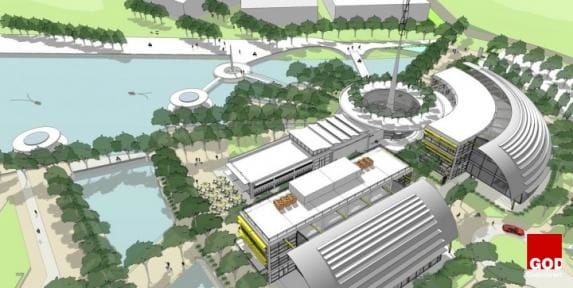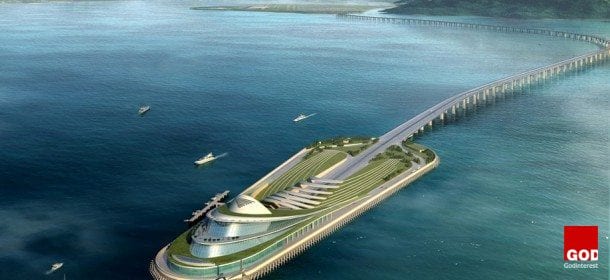Has Nigeria Become the World’s Junk Yard of Abandoned and Failed Mega Projects worth Billions?
Dim1, N. U., Okorocha2, K. A., & Okoduwa3 V. O.
The Nigerian construction industry is mostly concerned with the development and provision of projects such as roads, bridges, railways, residential and commercial real estates, and the maintenance necessary for the socio-economic developments contributes immensely to the Nigerian economic growth (Bureau of Statistics, 2015). Butcher and demmers (2003) described projects as an idea which begins and ends by filling a need. However, a project fails when its idea ends without meeting the needs and expectations of its stakeholders.
Nigeria Has Become the World’s Junk – Yard of Abandoned and Failed Projects worth Billions of Naira!
Hanachor (2013), revealed that projects form part of the basis for assessing a country’s development. However, a damming report from the Abandoned Projects Audit Commission which was set up by the Ex-President Goodluck Jonathan in 2011 revealed that 11,886 federal government projects were abandoned in the past 40 years across Nigerian (Abimbola, 2012). This confirmed the assertion by Osemenan (1987) “that Nigeria has become the world’s junk –yard of abandoned and failed projects worth billions of naira”.
Abandoned projects including building and other civil engineering infrastructure development projects now litter the whole of Nigeria.
Physical projects do not only provide the means of making life more meaningful for members of the community where the projects are located, successful projects also result in empowerment and collective action towards self improvement (Hanachor, 2013).
This Issue of Abandonment Has Been Left Without Adequate Attention for Too Long, and Is Now Having a Multiplier Effect on the Construction Industry in Particular and the Nigeria’s National Economy as a Whole. (Kotngora, 1993)
PROJECT FAILURE
Project Failure might mean a different thing to different stakeholders. A project that seemed successful to one stakeholder may be a total failure to another (Toor and Ogunlana, 2008). Some stakeholders, more especially the project users and some private owners, think of failed projects as a situation where a completed building project collapsed, a situation where by a completed dam project stopped working after few days of completion, or a completed road project that broke down after few months of completion. Other experienced stakeholders, such as engineers and architects conform to the iron triangle by Atkinson (1999) which states that the most strategically important measures of project failure are “time overrun”, “cost overrun”, and “poor quality”.
Turner (1993) noted that a project fails when the project specifications are not delivered within budget and on time; the project fails to achieve its stated business purpose; the project did not meet the pre-stated objectives; the project fails to satisfy the needs of the project team and supporters; and the project fails to satisfy the need of the users and other stakeholders. Lim and Mohamed (1999) cited in Toor and Ogunlana (2009) clarified that there are two possible view points to project failure namely; the macro-level and the micro-level. They further explained that the macro view point reviews if the original objectives and concepts of the project was met. Usually the end users and the project beneficiaries are the ones looking at the project failure from the macro view point, where as the project design team, the consultants, contractors, and suppliers review projects from a micro view point focusing on time of delivery, budget, and poor quality.
In the early 1990s, the failure as well as the success of any project was determined by the project duration, monetary cost, and the performance of the project (Idrus, Sodangi, and Husin, 2011). Belout and Gauvrean (2004), also confirmed that the project management triangle based on schedule, cost, and technical performance is the most useful in determining the failure of a project. Moreover, a project is considered as an achievement of specific objectives, which involves series of activities and tasks which consume resources, are completed within specifications, and have a definite start and end time (Muns and Bjeirmi 1996, cited in Toor and Ogunlana, 2009). Reiss (1993) in his suggestion stated that a project is a human activity that achieves a clear objective against a time scale. Wright (1997) taking the view of clients, suggested that time and budget are the only two important parameters of a project which determines if a project is successful or failed. Nevertheless, many other writers such as Turner, Morris and Hough, wateridge, dewit, McCoy, Pinto and Slevin, saarinen and Ballantine all cited in Atkinson (1999), agreed that cost, time, and quality are all success as well as failure criteria of a project, and are not to be used exclusively.
FACTORS OF PROJECT FAILURE
Cookie-Davies (2002) stated the difference between the success criteria and the failure factors. He stated that failure factors are those which contributed towards the failure of a project while success criteria are the measures by which the failure of a project will be judged. The factors constituting the failure criteria are commonly referred to as the key performance indicators (KPIs).
Time and Cost Overrun
The time factor of project failure cannot be discussed without mentioning cost. This is because the time spent on construction projects has a cost attached to it. Al-Khali and Al-Ghafly, (1999); Aibinu and Jagboro, (2002) confirmed that time overrun in construction projects do not only result in cost overrun and poor quality but also result in greater disputes, abandonment and protracted litigation by the project parties. Therefore, focus on reducing the Time overrun helps to reduce resource spent on heavy litigation processes in the construction industry (Phua and Rowlinson, 2003). Most times, the time overrun of a project does not allow resultant system and benefits of the project to be taking into consideration (Atkinson, 1999). Once a project exceeds the contract time, it does not matter anymore if the project was finally abandoned or completed at the same cost and quality specified on the original contract document, the project has failed. Furthermore, Assaf and Al-Hejji, (2006) noted that time overrun means loss of owner’s revenue due to unavailability of the commercial facilities on time, and contractors may also suffers from higher over heads, material and labour costs.
Poor quality/Technical Performance
The word “Performance” has a different meaning which depends on the context it is being used and it can also be referred to as quality. Performance can be generally defined as effectiveness (doing the right thing), and efficiency (doing it right) (Idrus and Sodangi, 2010). Based on this definition of performance, at the project level, it simply means that a completed project meets fulfilled the stakeholder requirements in the business case.
CAUSES OF PROJECT FAILURE
A lot of research studies have investigated the reasons for project failures, and why projects continue to be described as failing despite improved management. Odeh and Baltaineh, 2002; Arain and Law, 2003; Abdul-Rahman et al., 2006; Sambasivan and Soon, 2007; all cited in Toor and Ogunlana, 2008, pointed out the major causes of project failures as Inadequate procurement method; poor funding and availability of resources; descripancies between design and construction; lack of project management practices; and communication lapses
The contract/procurement method
A result obtained from two construction projects which were done by the same contractor but using different procurement methods showed that rework, on the design part which occurs when the activities and materials order are different from those specified on the original contract document, makes it difficult for the project to finish on the expected time (Idrus, Sodangi, and Husin, 2011). This is as a result of non-collaboration and integration between the design team, contractor, and tier suppliers. The rework on the design portion has a huge impact on project failure leading to the time overrun. The traditional method of procurement has inadequate flexibility required to facilitate late changes to the project design once the design phase of the construction project has been concluded.
Nigerian most widely used procurement method is the traditional method of procurement (design-bid-construct) which has been confirmed to be less effective to successfully delivery of a construction project (Dim and Ezeabasili, 2015). And, the world bank country procurement assessment report (2000) cited in Anigbogu and Shwarka, (2011) reported that about 50% of projects in Nigeria are dead even before they commence because they were designed to fail.
The way the construction projects are contracted, in addition to the way the contracts are delivered, contributes to the causes of projects failure. Particularly, among the methods of project contracting is lump-sum or a fixed-price contracting method, in which the contractor agrees to deliver a construction project at a fixed price. The fixed-price contract can be low-bid or not however, once the contract cost has been agreed upon the contract award, it cannot be changed. And, contractors are expected to honor and deliver the contract agreement, failure to do so can result in a breach of contract which can result in the contractor being prosecuted.
Awarding a contract to an unqualified personnel also contributes to project failures. When a contractor places more emphasis on money and the mobilization fee after a construction project has been initiated instead of getting the right workforce and skilled professionals that will execute the project. Instead the workforce chosen will often not be base on competence and required skills rather it will be based on availability. Moreover, poor strategy and planning by contractors who have overloaded with work also contributed to one of the causes of project failure.
Poor funding/Budget Planning
A lot of public projects in the Nigerian construction industry failed as a result inadequate funding, and the difference between the national annual budget and the budget actual released. Most of the Nigerian public projects are signed even before the actual release of the national budget. The difference in budget of the contracted project and the actual budget release can get the contracted company stuck as a result of inflation of prices, scarcity of construction material at the time of the budget release and mobilization to site. Also un-planned scope of work which can be as a result of the contractor working on another contract when he is called back to mobilization to start work. Moreover, poor budget planning is a regular mistake made by some contractors by not undertaking feasibility assessments before starting the design. The construction project should be planned according to the available resources and not according to the unrealistic expectations a client has in mind.
Discrepancies Between the Design and Construction
Limited collaboration between the contractors, engineers, and the architect results in discrepancies between the project designs and construction on site, and further leads to rework. Changes on a project designs, and changing to the scope of work in the middle of construction processes on site can be dangerous, and can lead to time overrun, increase in cost, and most of all can lead to abandonment. Moreover, many cases have been seen where the designs from the architects are not buildable on site, while In some cases, most contractors are unable to adequately specify the scope of work for the construction processes on site. Therefore any default on the design by the architect can be an opportunity for the contractor to make more money which might cause the project duration to exceed the time specified on the contract document.
RESEARCH METHODOLOGY
This research starts with a general reasoning or theory which says that the major cases of project failure in the Nigerian construction industry are defined based on time overrun and cost overrun. The findings from the data analysis will help on the decision to accept the theory or not. The research data was collected from the progress report for the month ending of October, 2015 published by the Nigeria of Federal Ministry of works on thirty-nine on-going highway construction projects at the South-South geopolitical zone. The table 1 below shows the information on the data collected which comprises of the project title, contract Number, project description, the contractor that was awarded the projects, the date of project commencement, date of completion and the extended date if any. The scheduled time for each project was specified as follows: project commencement date labeled as “a”, project completion date labeled as “b”, and the extended date labeled as “c”.


DATA ANALYSIS
The data analysis was done with the use of Microsoft excel. The analysis started by obtaining the number of days between the date of commencement of each project and the date of completion to show the duration of each highway project. And, the number of days between the project completion date and the extension date showed the time-overrun. The project duration and the extended days were obtained with the use of NETWORKDAYS function in Microsoft Excel which calculates the number of working days between two dates excluding weekends and any dates identified as holidays.
The standard deviation between the specified project duration for each highway projects and the extended days was calculated to obtain the extent to which each highway project contract failed on its time of delivery. This was denoted as the degree of failure. The table 1 above showed the projects ranking which was done based on the degree of failure of all the highway projects. The highway projects that were ranked from one to sixteen have low degree of failure and are represented with green color, while the rest are those with high degree of failure and are represented with red color.
FINDINGS
The findings made showed that the successfully completed highway projects have no extended days or time overrun, and the successful on-going highway projects are still on schedule and have no extended days unlike the on-going highway projects that have already failed as a result of the extended dates. Other projects have been abandoned because they have exceeded the delivery date as specified on the contract document, and have no extended date of completion. Thus, no work is going on.


Figure 2 above showed that 14% of highway projects are still on-going projects because they have not exceeded the original date of completion as specified on the contract document. However, they are heading towards failure because they have been given an extended date of completion which can be as a result of some critical activities running behind schedule, causing delay on the critical path network of the projects. Moreover, the other 86% completely failed because they have exceeded their completion date specified on the contract document.

The figure 3 above showed that 63% of the successful highway projects are still on-going because they have not exceed their completion dates, and they are not yet completed. However, those on-going highway projects might end up as failed projects as a result of poor funding, discrepancy between the design and the construction on site, and conflict between the construction parties or stakeholders.
“Say what you will do, and do what you said” or “Say as you will do it, and do it as you said”
CONCLUSION AND RECOMMENDATION
The idea of knowing what a failed project is, the factors and the causes is very important in project management. Success in project management can neither be achieved nor measured without the knowledge of project failure, its factors, and causes in the Nigerian construction industries. This work has shown that project failure is as a result of exceeded time of delivery, cost overrun, and poor quality. However, the analysis was only done based on exceeded time of project delivery because of the nature of the data collected.
This work suggested a few approaches to help reduce the number of failed projects in the Nigerian construction industry if properly implemented. Firstly, Having good collaboration between the project stakeholders involved in a construction project at the early stage of project conception is most important in order to accomplish the project objectives, and deliver the project on time, within budget, and quality specified on the original contract document (Othman, 2006).
Secondly, Adopting the ISO 9000 technique which is used for quality management will also help in achieving a successful project delivery. This technique states “ say what you will do, and do what you said” or “say as you will do it, and do it as you said”. This technique is not an indication of high quality but it promotes control and consistency which leads to specialization, and improved productivity and quality. Also, adopting the principles of lean construction will help to reduce waste within the construction and stream-line activities in order to improve the on-time delivery of projects.
Thirdly, Learning from the precedent failed projects, how those projects failed, and the reason for their failures. This will help the project manager to plan and mitigate the risks of project failures in the future. And, finally, more seminars and workshops will help to educate and enlighten clients (the federal government representatives), users, contractors, engineers, and architects on what is project failure, the factors that contributes to abundant failed projects, and their causes.
REFERENCE
Abimbola, A. (Novermber 24, 2012). About 12,000 Federal Projects Abandoned across Nigeria. Premium times (November 16, 2015). Retrieved from www. Premium timesng.com/news/108450-about-12000-federal-projects-abandoned-across-nigeria.html.
Al-Khali, M.I and Al-Ghafly, M.A. (1999). Important Causes of Delays in Public Utility Projects in Saudi Arabia. Construction management and Economics, 17, 647-655
Aibinu, A.A and Jagboro, G.O. (2002). The Effects of Construction Delays on Project Delivery in Nigeria Construction Industry. International journal of Project management, 20(8), 593- 599.
Anigbogu, N. and Shwarka, M. (2011). Evaluation of Impact of the Public Procurement Reform Program on Combating Corruption Practices in Public Building Project Delivery in Nigeria. Environtech Journal, 1(2). 43-51.
Assaf, S. and Al-Hajji, S. (2006). Causes of Delays in large Construction Projects. International Journal of Project Management, 24, 349-357.
Atkinson , R. (1999). Project management: Cost, time, and quality, two best guesses and a Phenomenon, it’s time to accept other success criteria. International Journal of project Management, 17(6), 337-342.
Belout, A and Gauvrean, C. (2004). Factors Influencing the Project Success: The impact of human resource management. International Journal of project Management, 22, Pp. 1-11.
Butcher, N. and Demmers, L. (2003). Cost Estiumating Simplified. Retrieved from www.librisdesign.org.
Cookie-Davies, T. (2002). The Real Success Factors on Projects. International Journal of Project management, 20(3), 185-190.
Dim, N.U. and Ezeabasili, A.C.C (2015). Strategic Supply Chain Framework as an Effective Approach to Procurement of Public Construction Projects in Nigeria. International Journal of Management and Susutainability, 4(7), 163-172.
Hanachor, M. E. (2012). Community Development Projects Abandonment in Nigeria: Causes and Effects. Journal of Education and Practice, 3(6), 33-36.
Idrus, A., Sodangi, M., and Husin, M., H. (2011). Prioritizing project performance criteria within client perspective. Research Journal of Applied Science, Engineering and Technology, 3(10), 1142-1151.
Idrus, A. and Sodangi, M. (2010). Framework for evaluating quality performance of contractors in Nigeria. International Journal of Civil Environment and Engineering. 10(1), 34-39.
National Bureau of Statistics (January, 2015). Nigerian Construction Sector Summary Report: 2010-2012.
Kotangora, O. O. (1993). Project abandonment, Nigerian Tribune.
Osemenan, I. (1987). Project Abandonment. New Watch Magazine, Vol. 1, pp. 15.
Othman, M.,R. (2006). Forging main and sub-contractor relationship for successful projects. Retrieved from http://rakanl.jkr.gov.my/csfj/editor/files/file/projek/lessonslearned/MAIN&SUB_2.pdf
Phua, F.T.T and Rowlinson, S. (2003). Cultural Differences as an Explanatory Variable for Adversarial Attitude in the Construction Industry: The case of HongKong. Construction Management and Economics, 21, 777-785.
Reiss, B. (1993). Project Management Demystified. London: E and FN Spon Publishers.
Toor, S. R. and Ogunlana, S. O. (2008).Problems causing Delay in Major Construction Projects in Thailand. Construction management and Economics, 26, 395-408.
Toor, S. R. and Ogunlana, S. O. (2008). Critical COMs of Success in Large-Scale Construction Projects: Evidence from Thailand constructuction industry. International Journal of Project management, 26(4), 420-430.
Toor, S. R. and Ogunlana, S. O. (2009).Beyound the “Iron Triangle”: Stakeholder perception of key performance indicators (KPIs) for large-scale public sector development projects. International Journal of Project management, doi: 10.1016/j.ijproman.2009.05.005.
Toor, R. and Ogunlana, S. (2009). Construction Innovation: Information, process, management. 9(2), PP. 149-167.
Turner, J. R. (1993). The Handbook of project-Based Management: Improving the process for achieving strategic objective. London, McGraw-Hill.
Wright, J., N. (1997). Time and Budget: The twin imperatives of a project Sponsor. International Journal of Project Management, 15(3), 181-186.
Modular Eco-house System
9 Suggestions for Overcoming Barriers to Good Design When Using Modern Methods of Construction (Mmc)
The term ‘Modern Methods of Construction’ (MMC) embraces a range of technologies involving various forms of prefabrication and off-site assembly.
MMC is increasingly regarded as a realistic means of improving quality, reducing time spent on-site, improving on-site safety and addressing skills shortages in the construction of UK housing.

The variety of systems now available potentially allows the designer enough choice to sidestep problems deriving from constraints posed by the use of any one method. MMC systems, from closed-panel timber framed systems to bathroom pods are a palette from which designers can make choices. They are not necessarily stand-alone solutions that anticipate all the needs of an individual site and can be mixed and matched as appropriate.
These limitations are not obstacles to achieving the good design in MMC-based schemes, but may hinder the incorporation of more complex and innovative types of MMC from which greater overall benefits may be obtained which are considered under the following headings:
1. COST UNCERTAINTY
There is no doubt that, given products of comparable performance the key issue in purchases of MMC construction systems is the price. At present not enough is known about the potential costs of using volumetric and closed panel systems to enable confident specification at an early date. This inhibits designers from exploring the full potential of MMC systems. This is particularly true of the less repetitive, small, one-off scheme, where a smaller margin of benefits is gained from using MMC. The principal barrier to the uptake of MMC, therefore, seems to be the perception of cost uncertainty with respect to using more complex systems. Without doing substantial project-specific research, consultants and their clients simply do not know with enough degree of certainty how much the volumetric or closed panel systems are likely to cost, and what would be the savings to overall project costs produced by potential speed gains to offset against increased capital expenditure.
This is due to the complexity of assessing the ratio of cost of repetitive elements where pricing is relatively straightforward to the cost of adjusting elements or building in another method for the abnormal condition. Decisions to use innovative systems are likely to be made once designs are well progressed to enable teams to be more certain of costs. This can increase the potential for change or result in design compromise as the designer attempts to incorporate the specific limitations of a particular system in their design.
In an attempt to improve this situation, the MMC consultant and or clients could pull together a directory of MMC expanded to include cost comparison data. The huge range of variables involved inevitably makes this difficult, but a database of current construction cost information would be an invaluable resource.

2. PLANNING PROCESS AND EARLY COMMITMENT TO A SYSTEM
The time it can take to obtain planning permission has obvious implications both for project cost but also, in some circumstances, for architectural design innovation.
Most of the more complex types of MMC have an impact on dimensioning, the choice of external finish and detailing may have some effect on the buildings mass. Therefore, the construction system should be chosen prior to a planning application to avoid abortive work, redesign or amendment, or even resubmission for planning permission.
However, developers whose money is at risk, frequently hold off deciding on the construction technique until the last practicable moment, in order to get any advantage from fluctuations in material or component pricing.
Given the potential for lengthy duration of planning applications, this means that there is little incentive to prepare initial designs for planning with a prior decision to incorporate MMC firmly embedded. In cases where the developer has a financial or business link with the supplier, this is less likely to be the case. As the majority of commercial or residential developments involve some kind of arrangement with a developer, agreement on construction systems is often left to the stage after planning.
3. TIME INVESTMENT
Another very significant factor is the time investment required at the early stages of projects. This is needed to develop the design when the project is still at risk. There is a direct relationship between the scale and complexity of MMC component and the amount of time required to develop a design at an early stage.
The introduction of advanced or complex MMC techniques into the design process is potentially costly to the design team. A significant amount of research is needed to explore alternative systems, to obtain verification of suppliers’ credentials, investigate mortgage and insurance issues, visit previous sites, talk to system suppliers, obtain technical performance guidelines, understand junctions and interfaces, coordinate other consultants, obtain building control input and so on.
For a consultant, the only way of investing in this research is either through timely payment of increased fees by a visionary understanding client or through the anticipation of increased future productivity through repetition when a project is phased, or large enough, or likely to be followed by another similar project.
The potential of learning a system and then being able to repeat lessons learned efficiently is a powerful incentive for both client and consultant. By contrast, HTA’ s project at Basingstoke is an example of a phased project with a three to four-year duration allowed the design team to repeat various elements of the design, and the manufacturer to develop improved solutions to technical and supply problems.

4. INSUFFICIENT COMMUNICATION
Improved dialogue at the outset of the project is vital if design quality is to be maximised. Constraints and opportunities implicit within a particular system are more easily incorporated into design if partners communicate pre-planning. Increased early communication can be fostered through improved long-term partnering relationships.
Clients should also partner with a range of suppliers and architects so that choice and flexibility is not restricted.
5. INEXPERIENCE
Generally, the inexperienced client or design team will have to do more research, with the result that there is likely to be significant design development without a specific system being incorporated.
This is a disincentive to using a more complex system involving a higher proportion of MMC, where early decision making and knowledge of a system’ s capabilities have a decisive influence on the nature of the architecture. However, encouraging the take up of MMC through the use of a dedicated funding mechanism may assist clients in finding time for research into suitable MMC techniques.

6. SUPPLIER’S ROLE
Site capacity studies and early stage pre-planning design studies could be undertaken directly by system suppliers on behalf of clients, cutting out the usual procedure of commissioning design work by independent consultants.
7. ASSUMPTIONS
There are a number of assumptions that are generally held about certain types of MMC that may have been valid at one time but are no longer true today. There is a need for reliable and up to date information comparing system criteria, performance data, timescales, lead in times, capacity, construction time, sequencing issues, limitations, and benefits.
Therefore it would be helpful if a forum for discussion and experience exchange was set up.
8. DEMONSTRATING THE BENEFITS OF MMC
There is still a large amount of skepticism about the need to go very far down the line with MMC. This is reflected in the acceptance of the desirability of maintaining or indeed enhancing the pool of traditional craft skills throughout the UK.
A balanced view is that there is a demonstrable need for the wider use of MMC which is recognized by both industry and government. The best way for clients and the public generally to become more confident and knowledgeable about the quality of design achievable through MMC is to see it demonstrated.
9. FINANCIAL INCENTIVES
There is no doubt that spreading the burden of investment through the life of a project helps to ensure a higher standard of specification and hence quality. In the Netherlands, a ‘ Green Financing’ system has been developed by the Dutch government that provides favorable loan finance when certain sustainable standards are reached. In the UK, the Gallions HA has pioneered a study of this, based on a scheme in Thamesmead, ‘ the Ecopark project’.

Spectacular Architecture and Infrastructure Projects That Take Your Breath Away
The advent of the ‘megaproject’ is truly upon us as such projects become a key feature of city landscapes.
The Empire State Building, the Panama Canal, the Regatta Hotel in Indonesia – these are just a few of the architectural and infrastructure wonders of the world that you probably take for granted. With the National Geographic putting images on the map and now the Internet fuelling easy access to pics, it’s easy to forget how difficult these projects are for engineers to build. Behind the scenes, much goes on to tackle the making of a magnificent bridge, building or highway and byway. Here are a few such projects that should cause you to sit up and have your breath taken away because of their grandiosity, complexity and stunning beauty.
New York Residential Building


Still in the building stages, a residential towel at 432 Park Avenue is set to be one of the most expensive addresses in the U.S. Taller than the Empire State Building by 50 meters, the 426 meter building is considerably large, but plans to host just 104 apartments. Living in the building will cost you, though. If you’ve got $17 million you can start the process of bargaining for an apartment; however, the best apartments are the penthouses that will span an entire floor and go for $82 million or more.
The Panama Canal

Now that the Panama Canal has been in place nearly 100 years, we take for granted how it revolutionised trade and travel. The recent billion dollar improvement projects increased the length and width of the canal, adding more locks at both ends of the passageway connecting the Atlantic and Pacific oceans. Now that even bigger container vessels can travail the Canal, neighboring Nicaragua is in the planning stages of building its own canal – to the tune of $40 billion. The best and brightest engineers harnessed real ingenuity to figure out how to tame Mother Nature to advance the cause of expanding travel.
Hong Kong Zhuhai Macao Bridge, China

Hong Kong’s bridge project is one of the largest most complex in the world and uses a series of tunnels and bridges to connect three major cities: Hong Kong, Zhuhai and Macau. Costing more than $10 billion to build, it will drive the freight land transport needs of the region as well as facilitate the movement of passengers between the cities. The three-lane bridge and tunnel roadway includes the construction of two artificial islands to accommodate the building of the various roads involved with the project.
These and other architectural projects that defy gravity, plunge the depths of the ground and cover the sea are a wonder to behold. They put the best of human genius to work to solve complex problems such as how to build a bridge over a considerable expanse of water and accommodate tunnels under the water. The creativity of the world’s engineers and architects are put to the test, and they come up as winners every time with projects like the Park Avenue residential building, the Panama Canal and The Hong Kong-Zhuhai-Macau Bridge. However, the human mind still can’t come close to understanding the vastness of the whole universe. But as we get better at it, we clearly see two things: how tiny and insignificant man is by himself—and just how huge and wonderful is the plan that God most have for us!
2 Ways Residential Elderly Care Providers Can Drive Growth
The care sector is growing fast. People are its most valuable asset and investment in care-home developments is being fuelled by an ageing population and a growing demand for specialist skills.
Scalability and Replication Have Now Become the Building Blocks That Will Enable Residential Elderly Care Providers to Sustain Growth, Deliver Successful Change and Achieve High-quality Service Outcomes
Dean Jones, former Investment Growth Programme Manager for Care UK offers insight into how REC providers can take advantage of market opportunities by building a sustainable and scalable system. Jones’ experience includes programme managing a £250 million investment-growth programme from 2012 to 2015, which involved building and commissioning 20 new state-of-the-art care homes and their services. He also oversaw a £60 million 3-year investment in a Suffolk programme, for the building of 10 new care homes and 10-day clubs and bringing much needed additional nursing and dementia-specialist care to the community.
REC Providers Can Develop Their Own Blueprints to Replicate and Scale Growth
REC providers can learn much from Jones’ involvement with scaling successful care homes. In his work at Care UK, Jones employed innovative ideas for evolving the next generation of care homes and introducing a competitive edge through unique selling points to harness market potential. The trendsetting programmes have led to phenomenal success, with more than 30 new homes built over a five-year period, a level of growth rarely seen in this sector. Jones describes how REC providers can develop their own blueprints to replicate and scale growth.
Building a foundation
The organization relied on a guiding principle as it developed a scalable system. It consisted of a toolkit that would outline how to manage projects and launch new homes, along with the standard of care the organization expected once a home is operational. The first system in the toolkit, the Project Management Blueprint (PMB) consisted of methodologies, processes and systems that would guide the creation of an ambitious and exciting growth pipeline for new homes.
The Blueprint ensured that the programme and project’s team resources would deliver high-quality outcomes through the practice of sound project management, both at a programme and individual project level. However, the Blueprint was just one of three tools the organisation would use to govern the commissioning and operation of new care homes. The other tools, a Home Manager Launch Manual (LM) and a suite of Standard Operating Procedures (SOP), complemented the programme on the whole.
Building the Capability to Service the Demand Is the Key to Driving Growth
The blueprint
Creating the demand for growth and the environment for change is not enough to generate scalability. According to Jones, building the capability to service the demand is the key to driving growth. Instead of control, managers need to:
- Introduce a framework and certainty about processes.
- Implement repeatable best practices.
- Build the ability to drive quality.
- Equip people to do the best job possible.
- Introduce a suite of project documents that directly suit the organisation’s purposes while ensuring consistence use.
- Increase efficiency and productivity.
As a result of the Blueprint, Care UK was able to construct the building blocks for scalability and replication that would encourage change, growth and quality outcomes. When the foundation of an organisation is built on highly standardised and formal processes underpinned by highly developed performance-monitoring systems and the ability to control quality, it has a scalable business model. Another component involved in the process, evolving the product offerings through a process of service innovation enabled Care UK to apply standardised business-model concepts.
The requirements
Building a methodology for scalability involves considering project and business requirements first. Then, the organization can develop a system that meets the business and management-style needs to deliver successful outcomes. Jones employed a methodology that outlined the standard project-management methods to be used, and practices and guidelines to follow when managing new-home opening projects and business-transformation projects. With a disciplined, well-managed and consistent methodology, Care UK promoted the delivery of quality products and services, on time and within budget for each location.
The essential benefit of adhering to such a defined project- and programme-management methodology is the ability to demonstrate repeatable successes, rather than learning the same difficult lessons again and again. The objective of the methodology ensures that each new home opening was delivered to the highest possible standards via:
- High-quality product or service that adheres to the business case.
- Excellent standards of care and service.
- Financial performance that achieves or exceeds the business case.
- Homes or change initiatives delivered on time.
- Projects executed on budget.
Relationships
Effective working relationships are also critical to the success of large-scale projects. Management tactics based on a matrix structure ensure that functional and operational resources are aligned across the business. This approach results in significant advantages, as it enables effective and responsive participation from different parts of the organisation that have specialist expertise. In Jones’ matrix, people from different parts of the business took a lead role in managing a specific work stream and were known as Work Stream Leaders. Jones also adopted the RACI technique for identifying functional areas, key activities and decision points where ambiguities exist.
Project Lifecycle
The management of any large, complex project is made easier when broken down into more manageable chunks. This unique approach to the project’s lifecycle enabled Jones’ to establish clear controls, e.g. review points, or gateways, at which to consider progress before moving on to the next phase. The Care UK project lifecycle methodology consisted of five distinct stages, with each stage considered as a sequence, providing the structure and approach to progressively deliver the required outputs.
Risk and issue management
Focusing on critical risk issues helps programme managers mitigate threats. Regularly planning and leading benefit reviews helps organizations drive success and ensure that profits aren’t eaten up by largely avoidable risks. For example, a slight reduction to a home’s expected average weekly fee (AWF) – although based on a more up-to-date market analysis – could have a detrimental effect on the bottom line. However, if this market analysis re-evaluation were to take place at the pre-planning stages, then the organization has an opportunity to review down spec. Key decisions like these must be managed with due diligence and care, by referring to the original business case and using a clearly defined change-control process, and then directing such matters to the programme board for approval.
Recommendations
Programme managers embarking on a scalability journey should note that before diving into the planning of a system of methodologies and processes, it’s important to first understand what needs to be fixed. Jones began his appointment at Care UK by working with a small team. They spent time getting into the nitty gritty of launching care homes, reviewing checklists, liaising with the Care Quality Commissions (CQC), and understanding the business and identifying gaps. Only then did he present the findings and gain support for the project’s Blueprint. Managers also need to understand the organisational culture in which they operate, and then adapt their approach accordingly. Finally, gaining senior management trust is another critical step, as approval and support helps form links throughout the organization – including the lower-management levels.
Successful organizations need managers with a breadth of knowledge – not necessarily construction management expertise – to successfully drive the outcomes of the project. They also require some understanding of IT systems, staff, marketing strategy and more. Only then will the organisation reap the strategic benefits of higher management-level expertise. With the right approach to project management and creating repeatable systems, care home organizations can seize market conditions and drive growth, while delivering quality outcomes through scalable building blocks.
Professional Consultancy Responds to Health and Social Care Challenges
As people in the UK live longer, demand for residential care and nursing homes is growing, as are our expectations of the standard of living they will provide. Dean Jones offers insights about the value a professional consultancy has for overcoming the challenge and driving value for patients.
The current state of affairs
As a result of some well-broadcasted care scandals that attracted extensive, and in some cases, damaging media attention, the government has responded with cuts that are impacting local authority (LA) fees and resulting in far tougher Care Quality Commission (CQC) policies.
Office for National Statistics (ONS) Projects That by 2035 There Will Be 3.5 Million Uk Residents Aged 85 and Older, Compared to Only 1.4 Million Currently
In spite of this, the “extra-care” – or Residential Elderly Care (REC) sector – continues to overcome these challenges, attracting new investments, particularly into new-build care homes. These are specially designed, owner-occupied, self-contained housing, often with round-the-clock support and meals and sometimes with nursing assistance.
A typical pattern is for owner-founded care home operators to reach a growth limit, based on the founder’s management capacity, access to capital and appetite for risk. They cease to invest in new capacity and don’t benefit from economies of scale which can be passed on to commissioners. Public markets typically do not fulfil their function as a supplier of capital in the case of healthcare services, because they generally demand relatively modest gearing.
There’s a widely recognised need across all health and social care market segments for innovation and system change, as well as capital investment in new services. A private equity investor is well placed to leverage technical services to strategically programme and project-manage Residential Elderly Care (REC) public real estate schemes across their entire lifecycle.
Supply and demand challenges
Today, professional healthcare businesses and registered social landlords (RSLs) are the main providers of new capacity, period. Since 2008, private and voluntary status providers, who service 92 percent of all Residential Elderly Care, have reported an upswing in demand and occupancy. Paradoxically, as adult social care budgets are decreasing and the provision of residential care by the NHS and local authorities has shrunk, the number of UK people who require help and support is rapidly increasing.
The Increasingly Ageing Population of the Uk Appears to Be Underpinning the Overall Rise in Rec Capacity and Occupancy
While Local Authorities (Las) are seeking to divert placements to inexpensive non-residential/domiciliary-based alternatives, the increasingly ageing population of the UK appears to be underpinning the overall rise in REC capacity and occupancy. Britons are living longer than ever. The Office for National Statistics (ONS) projects that by 2035 there will be 3.5 million UK residents aged 85 and older, compared to only 1.4 million currently. The cost of caring for these residents is also forecasted to increase. For example, caring for a person with dementia will increase to $1,142,677 by 2025 and $2,092,945 by 2051. In total the government estimates that 1.7 million more adults will require some type of care and support over the coming decades.
As a result, the current number of nursing and residential care homes in the UK (over 381,000) will need to almost double over the next 20 years to cope with rising numbers of people aged 85 or more.
A bright future?
The demand for care will continue to rise as a result of life expectancy increasing and ageing. A robust REC independent sector arises primarily from the net increase in residential demand, and more recently, improved occupancy. These are the result of a number of competing forces:
- Demographics, with the ageing population expected to drive the demand for health and social care.
- Outsourcing, the long-term transfer of residents from LA homes to independent care homes.
- Severe financial constraints, at least over the next five years, as the government – which pays for the bulk of health, social care and special education – seeks to eradicate the public expenditure deficit and restrict new builds.
- Outdated assets, or older care homes that no longer meet needs.
- Consolidation, a trend within segments of the independent sector.
- Maturity, against a currently immature healthcare market.
- Efficiency, highlighted by the “Nicholson challenge” for the NHS to make £15 to £20 billion in efficiency savings between 2011 and 2014. (It costs the NHS approximately £3,000 a week to care for elderly patients with no clinical need to be in a hospital ward. By contrast, it comes to about £1,000 per week for a residential care home provider.)
- Demand and Occupancy. Unless the supply of new builds increases (currently by approx. 7,500 beds p.a.), it’s possible that some regions may see bed shortages, driving up LA fees.
- New Technology. Progressive management capabilities in leveraging technology and strategic collaboration will constitute the formula for success and sustainability in the new healthcare business environment.
While a longer life is welcome news for millions of Britons, it could ironically trigger a public service meltdown as our national health system is stretched to its breaking point. Local authorities and NHS trusts retain a significant role in delivering services, with 75 percent of nursing home places funded by the public sector. There exist ever-increasing opportunities for private care providers to take some of the strain from NHS and ease bed-blocking by caring for patients, mostly elderly, in a residential setting when there is no clinical need to be in a hospital ward.
The REC Sector Could Potentially save the Nhs Billions of Pounds.
A combined approach to health and social care and some innovation is required for this savings to become a reality. In addition, Care Home Operators have a unique opportunity to grow their businesses and benefit from economies of scale, leveraging the expertise and resources of a professional consultancy. In doing so, they’ll have necessary resources and systems to bid for significant re-provision of services tendered by local authorities.
About Dean Jones
Dean is an Associate in AECOM’s Programme Leadership Practice. Dean joined AECOM from Care UK, the UK’s largest independent provider of health and social care, where he was a Programme Manager and delivered a £250m investment growth programme over 2012/15 which increased Care Uk’s number of homes circa 33%. Dean was also Programme Manager for a £60m Suffolk programme to build ten new care homes and ten day clubs, bringing much needed additional nursing and specialist dementia care to the Suffolk community.


















